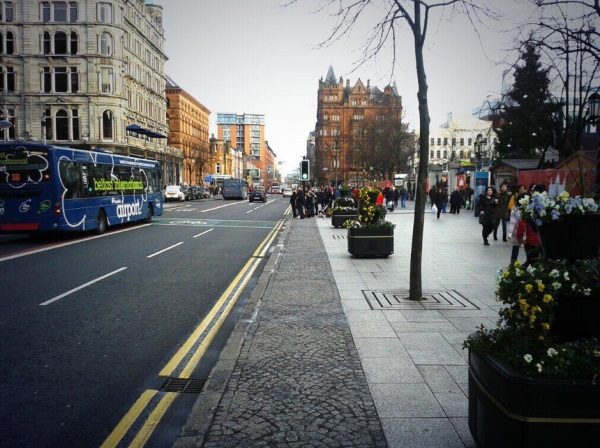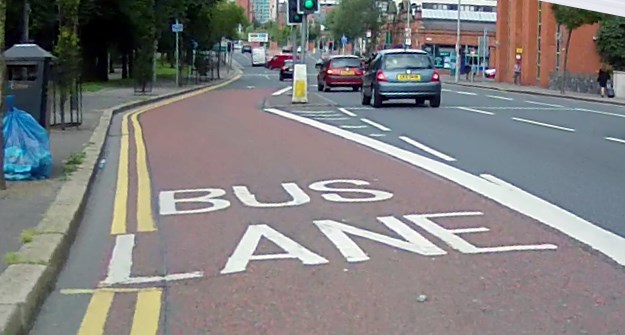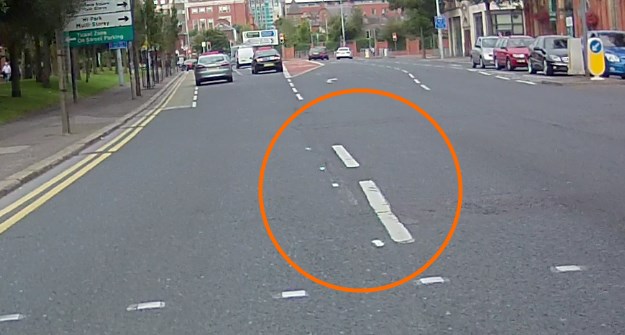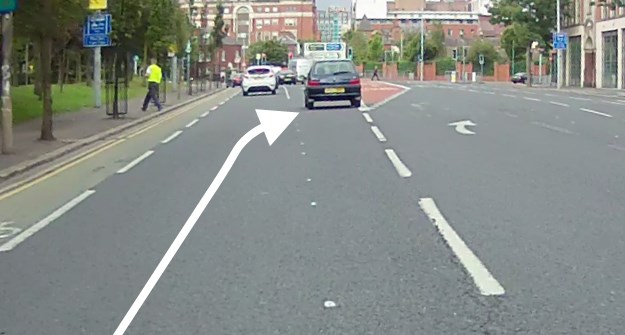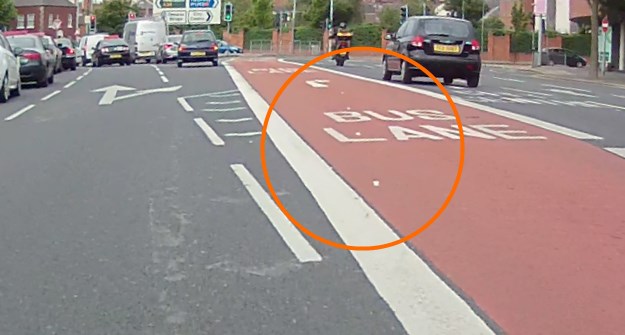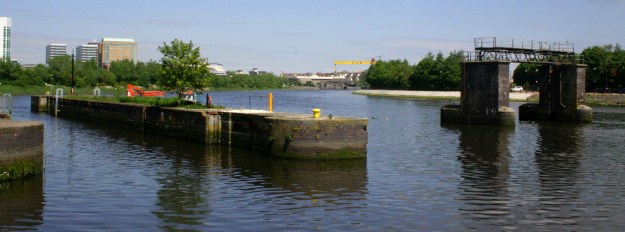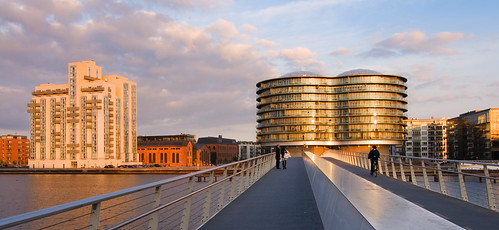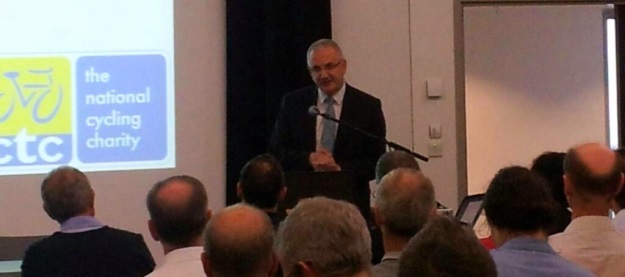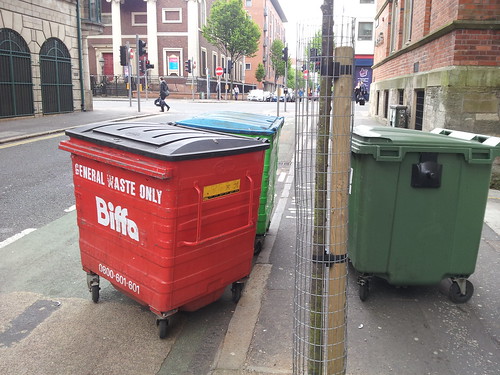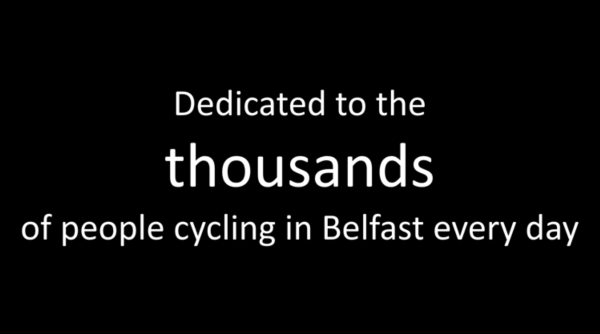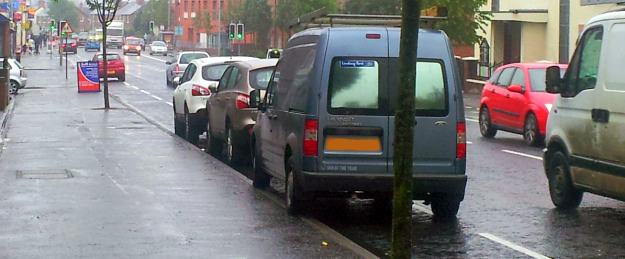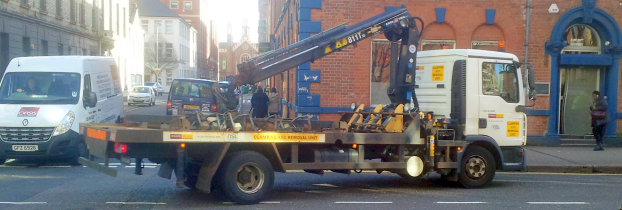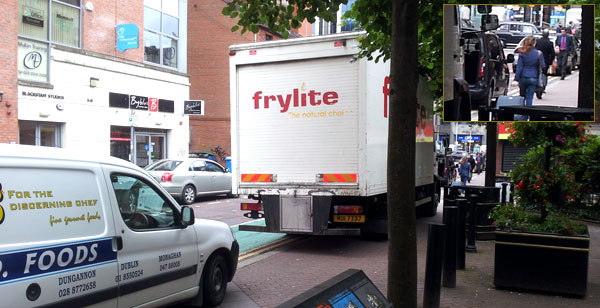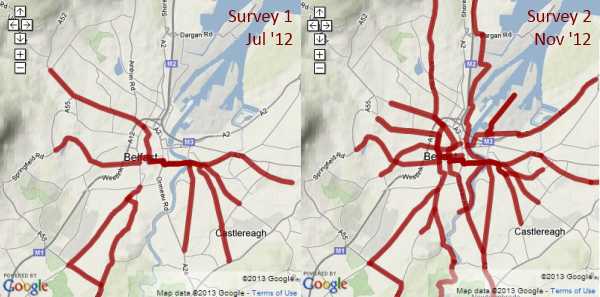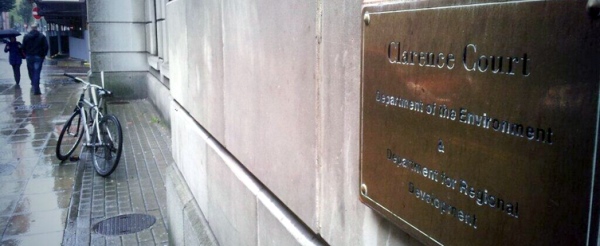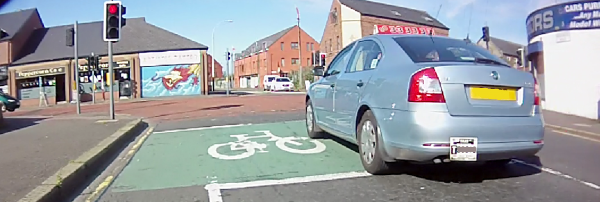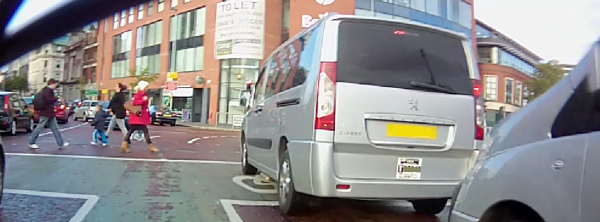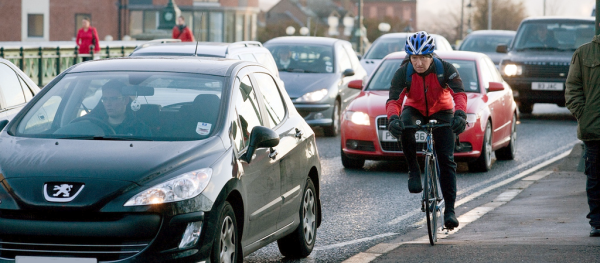
Regional Development Minister Danny Kennedy is in the final stages of considering whether to allow all taxis into bus lanes in Northern Ireland. What appeared just weeks ago to be a done deal in favour of the taxi lobby, has been thrown into the mix again by vocal opposition from ordinary commuters in Belfast. But are Departmental officials giving enough weight to the perception of safety among current cyclists, and crucially the thousands of people Belfast needs to convince to switch to the bike?
The case presented by the Department for Regional Development (DRD) for allowing all taxis into bus lanes is fundamentally weak. Private taxi firms are the only group lobbying for the proposal, and no compelling argument has been brought in favour. It remains the ‘easy’ solution for DRD’s dilemma posed by DOE taxi reform, yet transforms and exaggerates a small scale inconvenience for taxi drivers into a major worry for (current and potential) cyclists in bus lanes.
Taxis want access to bus lanes simply to speed past rush hour traffic – this is clear and obvious. Yet this clashes with both the requirement for an efficient, reliable and attractive bus service (DRD admit bus journey times will be slowed) and the view among cyclists that 2,000+ taxis threatens the sense and reality of safety and security on their journey.

Foxes in the chicken coop
Cyclists launched a campaign against the plan with a City Hall protest and a petition, handed in to the Minister on 13th March. Among the 500+ signatories, many added personal comments to the petition – 76% quoted “safety of bus lanes” as their major concern, effectively a ‘subjective‘ view that private taxis will lessen safety. Views on this ranged from individuals reconsidering their own journey choice to the common belief that it will damage cycling across the city.
Yet to counter cyclists’ fears, DRD officials have been quoting accident statistics in bus lanes. The following was part of a Roads Service submission to the Stormont Regional Development Committee:
“The main issue that was brought up in the consultation was the adverse impact to safety of cyclists, and if I could elaborate a little bit on that … the information we have in the last 3 years up to March ’11, showed that there were very few collisions actually in bus lanes, and of the collisions that were caused in bus lanes were actually crossing manoeuvres; vehicles that were actually crossing from the main traffic flow across the bus lane, possibly into side streets. That was the main cause. In fact the information we have, no accidents that were actually caused between vehicles that were actually allowed to use the bus lane, that were permitted to be there. So from that point of view, we feel that the vehicles that actually use the bus lane and the causation of accidents in the bus lane obviously isn’t an issue … we feel that it will not, hopefully, have a detrimental effect to the safety of cyclists.”
In one sense DRD have done their job correctly here – measuring objective safety and declaring that bus lanes are demonstrably safe spaces for cyclists. But DRD have told us what we already know, and why we’re trying to retain this ‘safer’ network. Not particularly enlightening.
On the other hand, the flawed logic could be compared to a farmer who protects his hen house with a wire fence and strong lock at night. With no evidence or experience of attacks on hens, he takes it as proof that allowing foxes into the coop shouldn’t be detrimental to the safety of hens.
Perception of safety is valued by policy makers (elsewhere)
There are moves to add perception of risk and safety to transport planning in other areas, notably by the Department for Transport in Whitehall. But it seems policy makers in Northern Ireland have little to go on other than collision stats. The situation is quite different in countries where cycling as transport is valued.
Copenhagen is a city where 36% of all trips to work or places of education are made by bike, and they are aiming for 50% as their next milestone between 2015 and 2025 (Belfast has no targets). In their current bicycle strategy document, there is a clear distinction made between accidents (objective safety) and the “sense of security” (subjective safety):
Traffic safety has been greatly improved over the past few years. Statistically, the risk of being involved in a serious accident has fallen by 72% per cycled kilometre since 1996. Copenhageners’ sense of security in the traffic has also improved of late. If this sense of security is to rise even further among current cyclists and potential cyclists alike, the most important areas of focus are creating more space on the cycle tracks, making intersections safer and using behavioural campaigns to improve consideration in traffic – including on the cycle tracks. The general traffic safety efforts are also very important. For example, reducing speed limits for cars where necessary.
In the Netherlands, the principles of ‘sustainable safety’ would mean conflict between fast taxis and slower cyclists would be designed out of, not into, road policy. SWOV, the Institute for Road Safety Research, has also studied subjective safety in traffic (for all users), and points out the weak relationship between objective and subjective safety – which at the very least should lead DRD to question the role of accident statistics as the sole determining factor in the taxi decision. Recognising that at the extremes fear of traffic may affect individual travel choice, the question must be asked about the value of improving subjective safety:
If the objective is the reduction of the number of road casualties, then improving subjective safety in traffic is hardly important. If the objective is to use feelings of being unsafe as an indicator for possible dormant road safety hazards, it is important to assess the validity of these complaints and signals. If the objective is to make people feel at ease in their living environment, and to prevent them from feeling that their own mobility or that of others is impeded by feelings of being unsafe in traffic, then improving subjective safety is important.
Should DRD be using an ‘objective’ measure to dismiss a ‘subjective’ fear, especially one which has great potential to limit personal choices? If the third goal listed above extends to the desire for adding more cyclists to the transport mix in Belfast, then DRD are duty bound to research, evaluate and seek to improve subjective safety of cycling, something worryingly absent from the consultation and the rush to bow to taxi firms’ wishes.

And in reality, it’s not as if DRD are lacking for evidence of a problem here. The PARC study linked to the ongoing development of the Connswater Community Greenway found that 60% of people felt roads were too dangerous for cycling, and this in an area of Belfast with some of the highest concentrations of commuter cyclists. Similar findings are available from just down the road in Dublin (report) in a city where for years all taxis have been allowed in bus lanes, or ‘pipes of steel’ as many cyclists would refer to them.
DRD’s own bible for road development, the Belfast Metropolitan Transport Plan 2015 (BMTP) deals with this area. If we quickly brush past embarrassing sentences like “On heavily trafficked roads cycle routes would be expected to be provided as fully segregated facilities” (Dutch-style paths in Belfast? Not on DRD’s watch!) we see that subjective criteria such as safety is considered important:
Attractiveness: Routes must be attractive to cyclists on subjective as well as objective criteria. Lighting, personal safety, aesthetics, noise and integration with the surrounding area are important (my emphasis)
But then judging by the preceding sentence, the BMTP is a wacky tome, from which planners can pick and choose as they desire (see: the largely forgotten Gasworks Bridge).
It’s fair to assume most people who signed the taxis in bus lanes petition cycle regularly on roads, and the message from those who added comments was clear. 76% of people specifically mentioned bus lanes as being valuable safe space for cycling. 25% believed taxis are a uniquely dangerous form of transport, 20% were convinced the plan runs contrary to DRD policies to promote sustainable transport, and interestingly 6% of people indicated that giving up cycling as a result of this plan was a serious option.
We’re making a clear point, but is anyone listening?
The problem with collision statistics #1
DRD’s evidence showing “accidents in the bus lanes obviously isn’t an issue” is based on existing bus lane conditions, which of course doesn’t include the private hire taxis that so concern cyclists. Not only will bus lane traffic be doubled, it will be made more competitive, with new faster vehicles mixing with existing slower users. If you don’t think taxis will create more dangerous situations for cyclists in bus lanes, here’s what William McCausland from Fonacab stated after the City Hall cycling protest:
“The taxis aren’t nearly as large as the buses, so their ability to manoeuvre around the cyclists is going to be much simpler.” Source: UTV
This is exactly the type of reckless attitude that has brought us to this point of protest. Most Belfast bus lanes are at most 3 metres wide. There just isn’t the required safe clearance for a saloon car to pass a cyclist within the boundaries of a bus lane with traffic to the right. This is the type of impatient manoeuvre we so fear, and Fonacab are clearly chomping at the bit to let their drivers engage in. It’s so worrying that a ‘professional road user’ running a taxi firm would have so loose a grasp of Rule 163 of the Highway Code.
“give motorcyclists, cyclists and horse riders at least as much room as you would when overtaking a car”

The problem with collision statistics #2
There is also the troubling issue of relying on collision figures as a true measure of objective road safety. Our friends from Cyclist.ie pointed to a startling piece of research was commissioned in Ireland to attempt to inform road safety policy with an idea of the under-reporting of RTCs. The report showed that the Road Safety Authority’s collision figures were grossly out of step with the numbers of people actually admitted to and discharged from hospital as a result of a RTC – which was 3.5 times greater.
However, when it came to cyclists, over the five year period from 2005-09 the RSA reported 109 seriously injured cyclists on Ireland’s roads. The number of hospital discharges for cyclists involved in a RTC in the same period was 1,050: “The difference in numbers is almost ten-fold“. This is truly shocking.
This struck me on a personal level. I was knocked down just over two years ago, by a vehicle using an operational bus lane illegally. I didn’t require hospital treatment, but at the same time I didn’t report the issue to the PSNI either. Another unreported collision, among how many every year in Northern Ireland?
Cycling in Northern Ireland becoming more dangerous?
Undeniably cycling is becoming more dangerous here, even before allowing taxis in bus lanes. Between 2004 and 2011 road safety has improved in Northern Ireland. However the rate of cyclists killed or seriously injured showed a sharp increase in 2010-11. Broadening it out to include minor casualties as well, the trend is upwards for cycling against a downward trend generally.

There’s little indication DRD have even recognised this as a particular developing problem, judging by the rush to place thousands of cyclists into conflict with thousands of taxis on tight bus lanes during the busiest periods on our roads.
Bus lanes = cycling network
How crucial are bus lanes to cycling in Belfast at present? DRD development of the Belfast arterial road network has produced a repeating pattern – citybound bus lanes for the morning commute, advisory cycle lanes mainly on the countrybound evening side, with some bus lanes substituting. According to DRD there is just 1.32 miles of segregated cycle tracks in Belfast, with many more areas shared with pedestrians, to varying degrees of usefulness/convenience/safety.
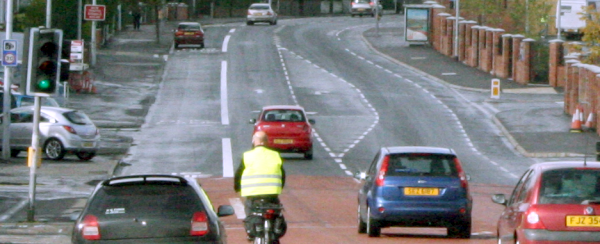
But the 48km of bus lanes constitutes a vast swathe of Belfast’s commuter cycling space, especially in the highly congested morning rush. Ignoring subjective safety concerns of existing cyclists will tip the balance of risk and reward in the favour of more private car travel, and all the problems that will bring for Belfast as a city trying to keep pace with modern development – while London’s vision puts us to shame.
The gut feeling that DRD have it all wrong
Ultimately this comes down to instinct. Those of us who currently use a bike on the road make our choice based on the balance of risk and reward for cycling in rush hour, and safer spaces have been demonstrated to make a difference even in Belfast, with rises of over 200% in a decade in some areas. Belfast is still in a period of cycling growth, but there’s no guarantee this will continue without investment in safer infrastructure and signalling to non-cyclists that safety concerns are being factored into transport planning. The gut feeling that roads are not a safe place to be on a bike clearly holds so many people back from cycling, male or female, young or old, rich or poor.
It’s not all bad news from DRD; this is the department which is radically altering Belfast city centre with the goal of improving sustainable transport. And they’re providing the kick start funding for Belfast Bike Hire, which has the potential to transform the city in the long run. But for that to be a success will require many thousands of people, many who have never cycled before, to feel safe enough to pedal the roads of Belfast. If it doesn’t feel safe, it just won’t be attractive.
We are fighting to hold back the tide, with bus lanes rightly valued as some of the safest road space we have. Our low levels of cycling will tell you that bus lanes alone are not the answer, and many people simply will not cycle in traffic at all due to fear. But if we value the rises in cycling seen recently, how can we expect to build upon it when the little safe space we have is being taken away and turned into taxi expressways?
